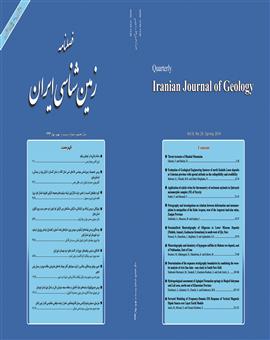ویژگیهای ژئوشیمیایی و منشاء منیزیتها در منطقه مزار سیدعلی، شرق ایران
محورهای موضوعی :
کلید واژه: منیزیت ایزوتوپ¬, های اکسیژن و کربن سرپانتینیت سنگ¬, های اولترامافیک مزار سیدعلی.,
چکیده مقاله :
کانسار منیزیت منطقه مزار سیدعلی در فاصله 105 کیلومتری جنوب بیرجند در حوضه فلیش شرقایران و در مجموعه افیولیتی «نه» واقع شده است. میزبان این کانسار سنگ های اولترامافیک به سن کرتاسه بالایی هستند که اغلب سرپانتینتی شده اند. نتایج تجزیه شیمیایی نشان می دهد که منیزیت مزار سیدعلی از MgO غنی و از SiO2 وCaO فقیر بوده و بنابراین برای استفاده در صنایع نسوز و دیرگداز مناسب می باشد. بهمنظور بررسی منشاء منیزیت های مزار سیدعلی، نسبتهای ایزوتوپی کربن و اکسیژن برای تعداد 8 نمونه منیزیت اندازهگیری شد که نتایج نشان می دهند، مقادیر 13CVPDB δ بین 60/8- تا 25/6- در هزار و 18OVSMOWδ بین 09/29+ تا 84/30+ در هزار متغیر می باشند. با توجه به مقادیر منفی13C δ و مقایسه آن با کانسارهای مشابه مشخص می شود که منشاء کربنات موجود در منیزیت های مورد مطالعه از کربن آلی میباشد که تحت تاثیر کربنات جوی واقع شده است. از طرفی دگرسانی شیمیایی و سرپانتینيتی شدن سنگ های اولترامافیک منطقه و تبدیل آن ها به سرپانتینیت باعث جدایش منیزیم گردیده که پس از واکنش با محلول های حاوی کربنات، منیزیت تهنشین شده است.
Magnesite deposit in Mazarseidali region is located 105 km South of Birjand in flysch basin in East Iran and within the Neh ophiolitic complex. The host rock for this deposit is serpentinized Upper Cretaceous ultramafic rocks. The results of geochemical analyses show that Mazarseidali magnesite is enriched in MgO and depleted in CaO and SiO2, and thus it can be used in refactory mineral industry. In order to evaluate the origin of Mazarseidali magnesite, oxygen and carbon isotope ratios for 8 samples were measured and the results show that δ13CVPDB and δ18OVSMOW values vary between -6.25 to -8.60 and +29.09 to +30.84 per mill, respectively. Considering the negative values for δ13C and comparing these with the values for similar deposits, it is determined that the source of carbonate (CO2) for the studied magnesites was from an organic carbon that was influenced by atmospheric carbonate. In addition, chemical alteration and serpentization of ultramafic rocks in the region and their transformation to serpentinite resulted in the release of Mg, that following the reaction with carbonates, led to the precipitation of magnesite.

